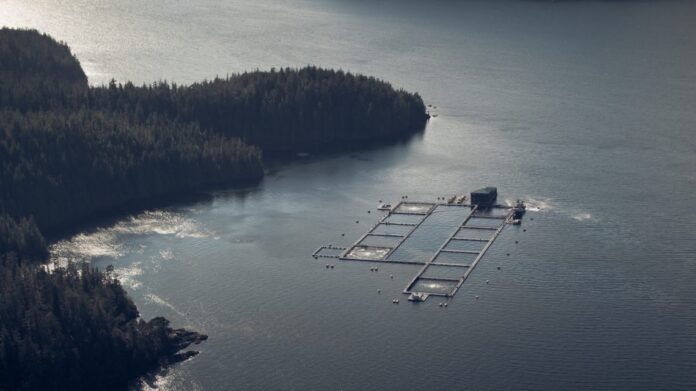Operational EBIT for Grieg Seafood was NOK 145 million (EUR 14.1 million) in the third quarter, stable from NOK 149 million (EUR 14,5 million) in the corresponding period last year. Harvest volume was 22,923 tonnes during the period (20,479), which gives an operational EBIT per kg of NOK 6.3 (7.3).
Results in Rogaland and Finnmark were positively impacted by a high share of superior fish, partly offset by contracts, timing of harvest in addition to lower average harvest weight in Finnmark. The cost level in Norway ended at NOK 49.8/kg, in line with guidance and up from NOK 42.7/kg in Q2 2022, primarily as a result of inflation. Production in the quarter was hampered by unfavourable biological conditions in both regions, which will impact full year 2022 harvest volumes. Production has gradually improved so far in Q4 2022, according to a statement from the company.
The Spiro parasite has been detected at some farms in Finnmark, where fish recently has been released to sea. The parasite has limited impact on fish welfare and biological performance for most fish, however, fish with sickness signs will be culled. The source of the parasite is believed to be water intake at a freshwater facility during a limited period of time, and correcting measures have been initiated. The incident is expected to have limited impact on future harvest volume as actions are taken to compensate the shortfall by transferring more smolt to sea and optimization of sites.
Results in British Columbia were negative during the quarter, with higher costs driven by reduced survival. The lower survival in seawater is mainly due to algae blooms on selected sites where the barrier system was not yet implemented. Production at remaining sites were good. As part of the strategy to improve biological control, the company is in process of installing algae mitigation barrier systems at exposed sites in the region.
As part of the company’s optimization strategy, Grieg Seafood have taken action to improve the site structure in BC, phasing out old sites with challenging biology and high cost. The management team is strengthened with a new COO for North America and Managing Director for BC.
In Newfoundland, fish released to sea is performing well and according to plan. So far, 2 million smolt have been released, currently with an average weight of 1 kg. First harvest is expected late 2023.
Commenting on the quarter, Andreas Kvame, CEO of Grieg Seafood, said:
“While the market and demand for salmon was strong for the season, the third quarter has been somewhat challenging. Our farming operations were impacted by unfavourable growth conditions and sea lice pressure in Rogaland and Finnmark, as well as algae blooms in BC. After implementing mitigating efforts, production has gradually improved and is expected to be stabilized in all regions in Q4. Seawater production in Newfoundland is developing according to plan. Looking forward, Grieg Seafood expects a continued strong salmon market where we will continue optimization of production with focus on fish health and welfare.”
“Political risk in Norway increased significantly as a result of the Norwegian
Government’s proposal to introduce a resource tax with an effective tax rate of 40 percent on farmed salmon. Grieg Seafood have previously identified large investment opportunities in our coastal communities in Norway aimed at advancing sustainable growth, however the proposal in its current form will significantly reduce available capital necessary for these investments. Therefore, all new investments that are impacted by the tax are put on hold. The proposal and the uncertainty caused by the political process in which it was launched shows how geographical diversification has become even more important to reduce risk in the industry. Grieg Seafood is together with the industry working to ensure that Norway remains competitive within the global salmon farming industry, with a stable and attractive investment climate. The proposal is subject to a public hearing and adoption by the Parliament. Once that has happened, Grieg Seafood will assess how the final outcome will impact our strategy and plans and adjust accordingly.”
The proposed tax in its current form is not neutral on investments and Grieg Seafood has put investments totalling NOK 2.3 billion (EUR 223 million) on hold until a final proposal is adopted.
Global harvest of Atlantic salmon in 2022 is expected to be in line with 2021. With no global supply growth for the rest of 2022, and limited growth in 2023, Grieg Seafood expects a continued strong salmon market going forward.
Over the last years, Grieg Seafood have been able to reduce the underlying farming costs through operational improvement initiatives. However, the general cost inflation, and high feed price in particular, are expected to continue to impact farming costs in the short to medium term. Grieg Seafood will continue to benchmark cost to its competitors to ensure the company’s competitive strength.
Grieg Seafood generally targets an annual contract share of 20-50 percent. Estimated contract share for the Norwegian operations in Q4 2022 is 32 percent.
In the fourth quarter of 2022, expected harvest volume is 17,500 tonnes, distributed as follows:
* Rogaland: 6,500 tonnes
* Finnmark: 9,800 tonnes
* BC: 1,200 tonnes
The company now guides for a harvest volume of 81,000 tonnes in 2022, down from the previously guided level 87,000 tonnes. For 2023, the company guides for a harvest volume of 87,000 tonnes, distributed as follows:
* Rogaland: 29,000 tonnes
* Finnmark: 33,000 tonnes
* BC: 20,000 tonnes
* NL: 5,000 tonnes









